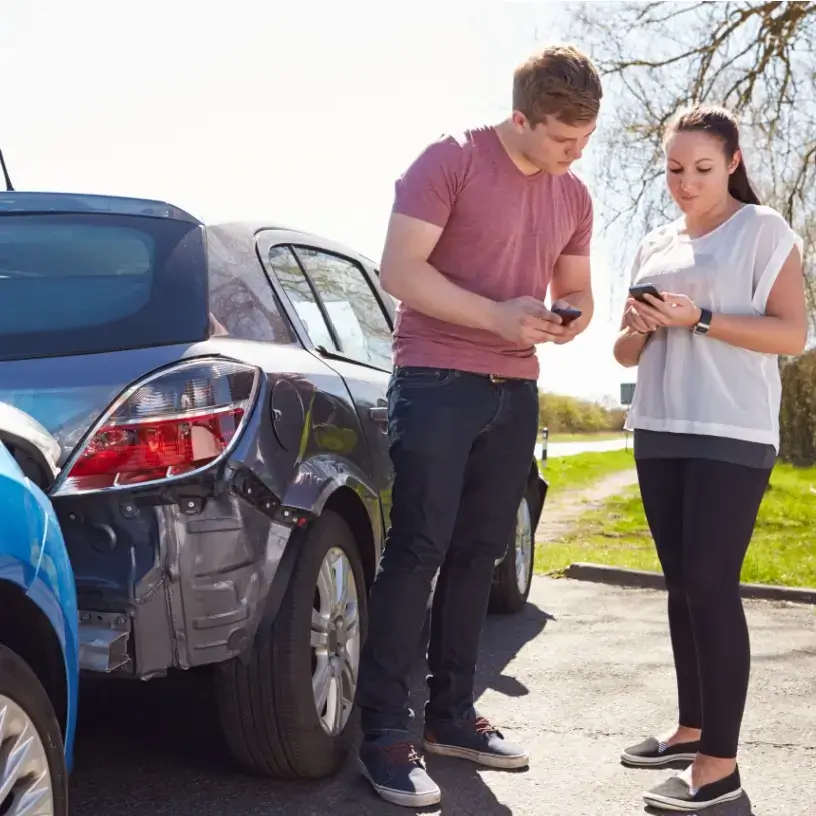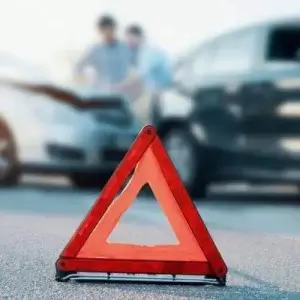Home / Compare Car Insurance / Not-at-fault car acciden…

Key takeaways
Not all car accidents you may be involved in will be your fault, but you should still know what to do when this happens and how to navigate your insurance. We’ll take you through all this and more, like:
- Gathering as much evidence as you can following a car accident so you can prove you weren’t at fault.
- Understanding what your rights and responsibilities are both when an accident occurs and when dealing with your insurer.
- How your car insurance policy can help you following a not-at-fault accident.
Expert tips for making a car insurance claim against another driver
Our resident car insurance expert, Adrian Taylor, has helpful tips for claiming for a not-at-fault accident.

Check whether your no claims discount will be affected
If you have a no claims discount, check whether a not-at-fault claim will affect your rating, as this can vary between insurers.
Stay on top of the repairs
If you’re not satisfied with the repairs done to your vehicle, contact the repairer or your insurer sooner rather than later to avoid any further disputes.
Make copies of dash cam footage if you have it
Dash cams can be very helpful when it comes to proving fault. If you have footage of the accident showing the other driver at fault, make digital copies and provide them to your insurer to help with the claims process.
What is a not-at-fault car insurance claim?
A not-at-fault claim is when you’re claiming for a car accident for which the other driver was completely responsible and liable for the loss or damages incurred. A not-at-fault claim is also one that is a recoverable claim from the other driver or their insurance provider.
Below is an example of a typical not-at-fault claim:
- A claim following an accident for which the other driver is completely responsible and you have recorded their identifiable details to provide your insurer.
Below are some examples of typical at-fault claims:
- If you are in a single-vehicle accident in which your vehicle is damaged such as running into a fence.
- If you are responsible for causing damage to another person’s vehicle or property while behind the wheel.
Please note if you can’t provide your insurer with the identifiable details of the other party who was involved in or responsible for a collision, your insurer may require you to pay an excess.
Making a not-at-fault claim
How do I make a car insurance claim when it’s not my fault?
 You’ll need to collect the details of the other driver involved when making your claim; this will generally include:
You’ll need to collect the details of the other driver involved when making your claim; this will generally include:
- The names and contact details of the other driver
- The other driver’s insurer and policy details
- The car model and registration number of other vehicles involved
- Details and statements from any witnesses of the accident
You can usually make a car insurance claim via your insurer’s online portal (typically by logging into your account), by calling your insurer’s claim line or by filling out a claims form and emailing or mailing it. If your insurer determines that your claim is a “not at fault claim”, it is likely that you will not have to pay an excess. While you typically need a comprehensive policy to cover damage to your vehicle arising from an accident or collision, in a not-at-fault claim with another insured vehicle, repair costs may be covered by the other party’s insurance.
However, if you can’t identify the at-fault party (e.g. the driver left before you could get their details), the damage to your vehicle may be covered under a comprehensive insurance policy subject to paying an excess. Be sure to check the relevant Product Disclosure Statement (PDS) of your policy to see whether you’re covered for damage to your car in an accident.
Will making a claim increase the cost of my insurance?
Making a car insurance claim can increase the cost of your insurance even if you’re not at fault. Remember that insurers do incur costs even when assessing a not-at-fault accident.
Will I have to pay an excess if I’m not at fault for a car accident?
If the at-fault party is identified and your insurer can contact them to process their details as a part of your claim, you may not need to pay the basic excess for your claim. However, it’s still possible you might need to pay an excess, depending on the circumstances of the accident. This should be refunded to you if it’s then recovered from the at-fault party.
You’ll typically have to pay an excess when making a claim if the at-fault party can’t be identified, or in circumstances such as hitting a kangaroo.
Is it worth making a car insurance claim if the damage is minor?
It is up to you to decide whether the damage is significant enough to you to warrant a claim. For instance, if the damage is only a minor scratch, you may decide to live with it and not have it repaired. In some cases, the excess payment could be more expensive than the cost of repairs for it, so you could save money by paying for the repairs yourself without making a claim. Always make sure you disclose any damage to your insurer when asked.
How to gather evidence after an accident
Following a motor vehicle accident, once you’ve established everyone’s safe, it’s time to gather evidence to help with your insurance claim. There are several things you should consider doing at this stage.
Get the other driver’s details
 Ask the driver for their details. This includes the driver’s name, phone number, licence details, address, vehicle registration number, make and model of their car, their car insurance provider and what car insurance policy they have. As well as recording these details, take photos of their identification card and licence plate.
Ask the driver for their details. This includes the driver’s name, phone number, licence details, address, vehicle registration number, make and model of their car, their car insurance provider and what car insurance policy they have. As well as recording these details, take photos of their identification card and licence plate.
Take photos
With modern smartphones doubling as cameras, taking pictures of an accident scene has never been easier. Take photos of all vehicles involved and at all points of contact and damage caused. If you have a dash cam, you can use the footage to help your claim, as this can show what happened rather than just what the resulting damage looks like.
Ask witnesses for statements
If there are witnesses who saw what happened, you can ask them for their contact details along with a written or recorded statement and any dash cam footage they have. Your insurer may need to talk to them through the process of assessing the claim.
Write down what happened
While it’s still fresh in your memory, make some notes about what happened for when you go to make your claim; note the date, time and location of the incident. Your insurer may need these details to process your claim.
Not all collisions will require the police or emergency services to attend but you must certainly involve them if anyone is injured or anything illegal is attributed to your accident e.g. if you suspect the at-fault driver to be under the influence of drugs or alcohol.
How your policy responds to a not-at-fault claim
Will I lose my no claims discount if I’m in a not at fault car accident?
Many car insurers offer a no claims discount, otherwise known as a no claims bonus or safe driver discount. This discount is based on the number of years you have driven without making a car insurance claim.
Some car insurance policies offer no claims discount protection that will maintain your discount if you make a claim. Having this protection typically costs extra, and there may be limits to how many claims you can make before losing your discount.
Will I receive a replacement vehicle while my car is being repaired?
This varies depending on the inclusions of your policy. You may receive a free hire car if you have cover for a replacement vehicle in your policy; this feature may be a standard inclusion in some comprehensive car insurance policies. Alternatively, cover for a rental car might be available to be purchased as an optional extra on your policy.
Important to know
Who’s at fault in a car accident?
 Insurance companies weigh the evidence of what happened against Australia’s road rules to see who was in the wrong and caused the crash. With more straightforward accidents, it’s typically easy to determine who’s at fault.
Insurance companies weigh the evidence of what happened against Australia’s road rules to see who was in the wrong and caused the crash. With more straightforward accidents, it’s typically easy to determine who’s at fault.
Sometimes, you and the other driver(s) can share responsibility if you were both somewhat at fault. This might happen, for example, if you both merge into each other while changing lanes or if one driver didn’t give way while you made an untimely yet legal turn. In these cases, your insurance company may attempt to negotiate with the other driver’s insurance provider to portion the blame, with any costs based on that amount of blame.
If the matter goes before a court, a judge will determine who shares what percentage of fault.
What if an uninsured driver causes the accident?
Should an uninsured driver cause an accident, you can make a claim with your insurer as usual. Generally, all levels of car insurance provide some form of cover if your car is damaged by an uninsured driver – though you still need to provide details to identify them. You’ll need to read your PDS and any disclaimers to check if this applies to your cover.
If you’re the uninsured driver but not at fault for a car accident, the process is a little different.
Do I need to call the police if I get into an car accident?
Australia’s state and territory police services note that in the event of a car accident, regardless of whether you’re at fault or not, you must call 000 if:1
- Someone has died or is injured
- The other driver refuses to provide any details
- You suspect drugs or alcohol were involved in causing the crash
- A driver with a disability requires assistance from the police
- Any public property damage has occurred (e.g. damage to power lines or barriers)
- There’s traffic congestion or another hazard threatening the public.
You can call the police following a crash on the nationwide non-emergency assistance line (131 444) to file a police report should any of these events occur.
You can get additional information on what to do after a car accident with our guide.
What do I do if the other person drives off before we can exchange details?
If the at-fault driver doesn’t stick around to provide their details, you can call the police to report the accident. For your insurance claim, try and note down as much detail as you can about the other driver and their car, such as make and model, license plate and any other details to help identify them.
What if there’s a dispute?
If the other driver disputes the claim, your insurance company may ask you for some additional details about the accident. They will then try to resolve the issue on your behalf with the at-fault driver’s insurer (if they have cover) or the driver involved if they have no car insurance. This usually involves sending a letter of demand to the at-fault driver, asking for compensation for the damages.
If all else fails, you may need to consult further with your insurance provider to assist in the dispute on your behalf. If you are still concerned with how your provider has dealt with your issue, you, as a consumer, have the right to involve an ombudsman from the Australian Financial Complaints Authority (AFCA).
Meet our car insurance expert, Adrian Taylor
As a General Insurance expert with over 13 years’ experience in financial services, Adrian Taylor is passionate about demystifying car insurance for consumers, so they have a better understanding of what they’re covered for. Adrian’s goal is to make more information available from more insurers, to make it easier to compare and save.
1 Traffic crash FAQs. Queensland Police. Queensland Government (n.d.). Retrieved October 2022.


